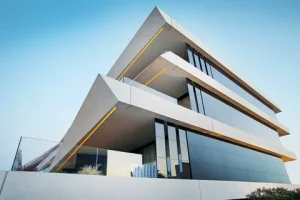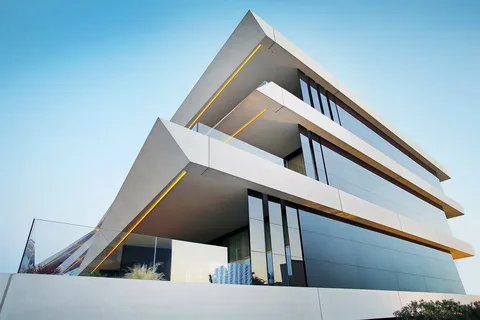Architecture and Interior design: A guide to key differences

Have you ever thought about how the striking details of a building differ from the cosy ambience inside it? That is the magic of architecture and interior design. With distinct flair, both these play unique roles in creating spaces we inhabit. When architecture focuses on the grand structure like functional layouts and forms, interior design focuses on the details like colours, furniture, textures, and everything else that will make the space feel like home.
So, whether you are planning to design a sleek skyscraper or a charming bedroom, understanding the differences is key. Are you curious about how an architectural design company navigate these two similar yet distinct realms? Join us as we explore what they are, and in detail about their aspects and differences. Let us discover what goes into shaping our everyday experiences.
What is architecture
In simple terms, architecture is often defined as the art and science of designing and constructing buildings and other physical structures. It is a multifaceted discipline and combines creativity, technical knowledge as well as problem-solving skills. This helps to create a space that is not only visually appealing but also functional, safe and sustainable.
Listed below are the main aspects of architecture
- Structure: Architecture is mainly about creating structures that stand the test of time. Designers and architects are responsible for designing the overall structure of a building, ensuring that it is stable, and safe and can also stand strong against different environmental factors. It also involves an in-depth understanding of physics, material science and engineering principles.
- Planning: Architects can create a layout and organisation of spaces within a building. This is done by considering factors like flow, functionality and accessibility and a decision is made based on how people will move through the space and use it. This ensures that the design is fully capable of meeting the needs of its unintended users.
- Exterior: in architecture, a crucial aspect is the outward appearance of the building. Architects design the building’s exterior and it involves considering the aesthetics, local context as well the purpose of the building.
- Site: Considering the site is yet another aspect of architecture. Because a building doesn’t exist in isolation architects will consider how to structure will suit the surrounding environment. This includes the landscape design as well as urban planning aspects.
- Regulation: They will also ensure that the design and the structure meet the building codes, zoning regulations and other legal requirements. One key step to do this is to stay updated with local as well as national regulations.
- Communication with clients: One must-have skill for architects is communication. They must be able to translate the vision of their client as it is and must be able to create concrete design proposals.
What is interior design
Unlike architecture, interior design is the art of enhancing the interior of a building to achieve a healthier and aesthetically pleasing environment for everyone using that space. This involves a combination of creative and technical solutions that are applied to a structure as it helps to achieve the desired interior environment the client is looking for.
Listed below are some of the aspects of interior design
- Planning the space: one of the major responsibilities of interior designers is that they have to optimise the layout of indoor spaces and this includes furniture, defining the functional areas and also ensuring that the space is less cluttered to ensure efficient flow of traffic within the building or a particular space.
- Lighting: There is nothing that plays a role as important as lighting in interior design. In order to create the right ambience and functionality in the space, designers plan and implement the lighting. This can be natural, artificial or even decorative fixtures.
- Colour and material: another aspect of interior design is that interior designers are experts in choosing colours, textures and materials that create the chosen atmosphere and aesthetic within a space. This is not an easy task because it involves a proper understanding of colour theory, material properties, etc.
- Sustainability: Just like architects, interior designers are also focusing increasingly on sustainable and eco-friendly design choices and this involves recycled and renewable materials, energy-efficient lighting and even furniture made from sustainable sources.
What are the major differences between architecture and interior design
-
Licensing
If you want to be an architect, you need a license but that is not the case with interior designers. Many designers, especially those into decorations are self-employed and they don’t need any special training or apply for licenses to take projects. Whereas, when it comes to architects, to get a license, they need to meet the essential educational requirements.
-
What they design
To put it in simple words, architects design buildings and structures whereas interior designers design the interior of these buildings and structures. Architects involve more on the technical side of the designing process whereas interior designers fill up and furnish the empty interior once the construction is over. Various tasks like selecting materials, choosing colour schemes, etc come within the scope of interior designers.
-
What they focus on
Interior designers mostly focus on aesthetics as their job is to create spaces that are aesthetically pleasing and functional by using colours, palettes, decorations and furniture placement. On the other hand, architects pay attention to the building materials, ventilation, climate aspects, etc.
Conclusion
To conclude, understanding the differences between architecture and interior design enriches and equips our appreciation for the spaces that we live and work in. From the stunning lines of a building to the inviting and warm details of a room, every element plays a vital role in our daily lives. So, whether you are exploring ideas of your own or even decide to collaborate with an architecture and interior design company, remember that the magic lies in finding the balance between form and function. So, think about it- what is that factor that inspires your ideal space? Let your imagination run wild. Because, after all, great design is always about dreaming big.
Begin the journey to creating your perfect environment today!

